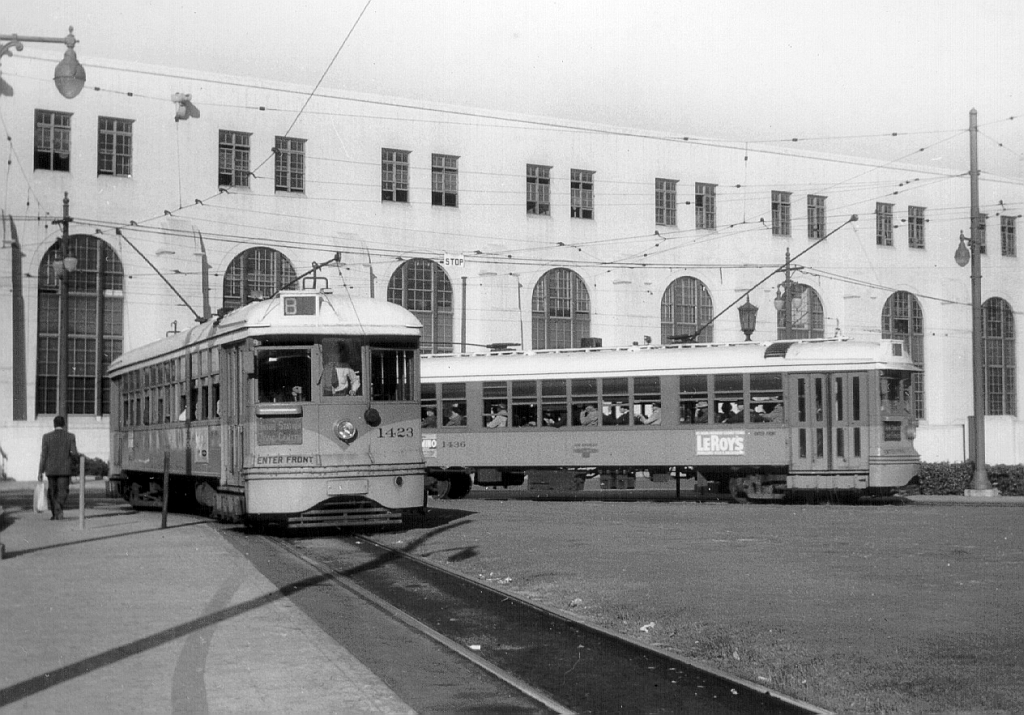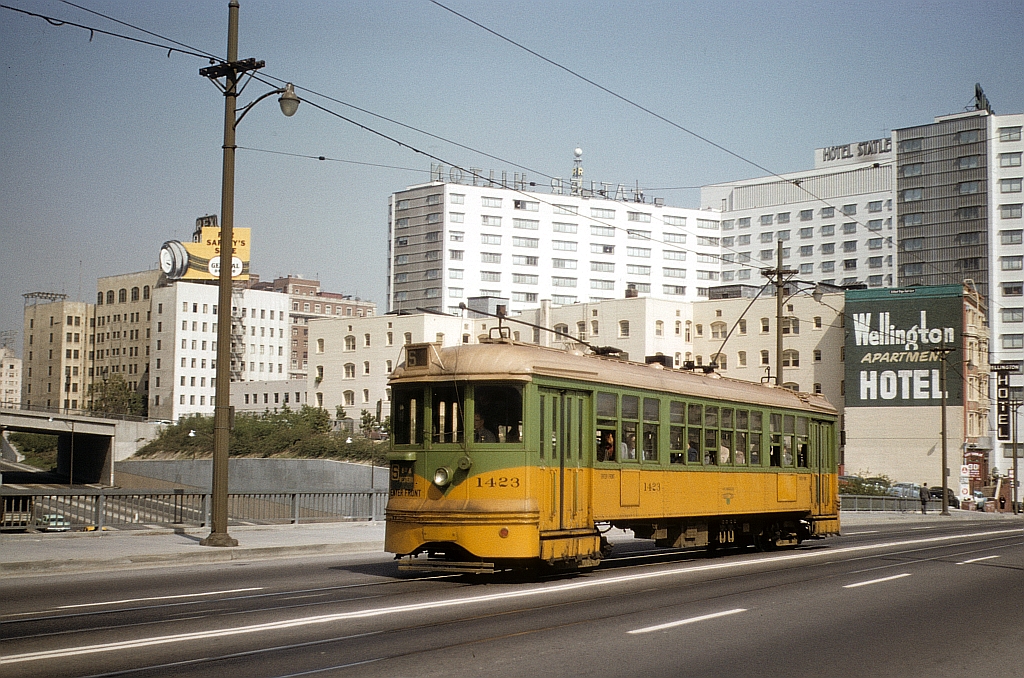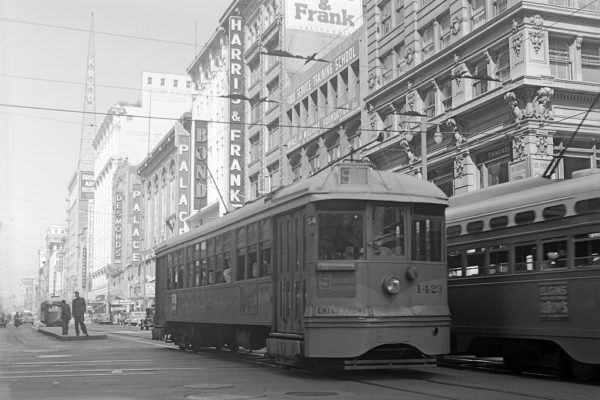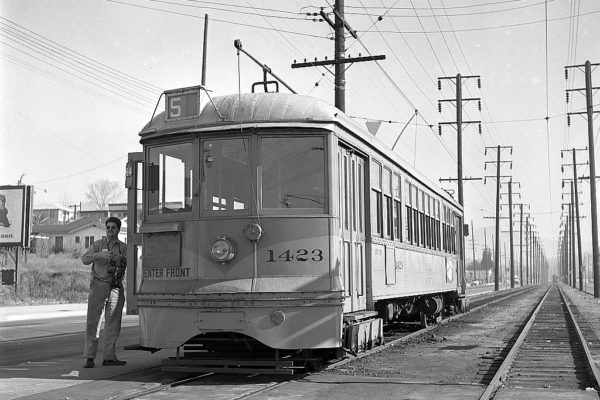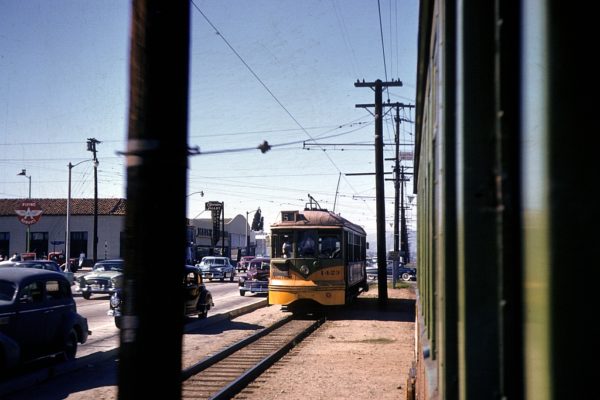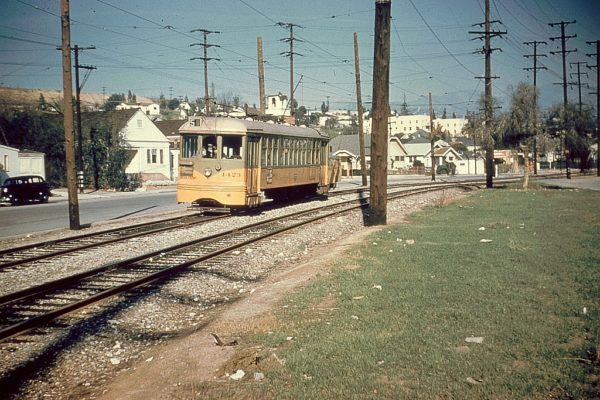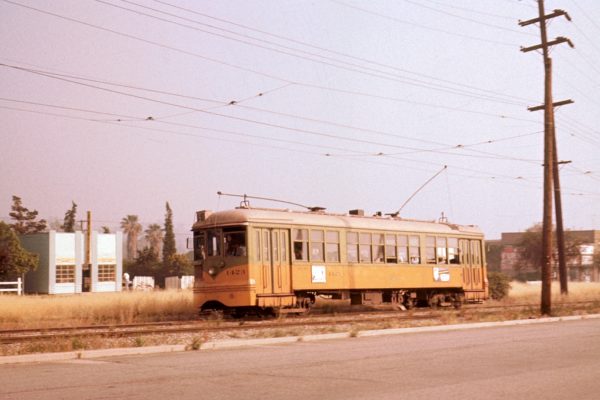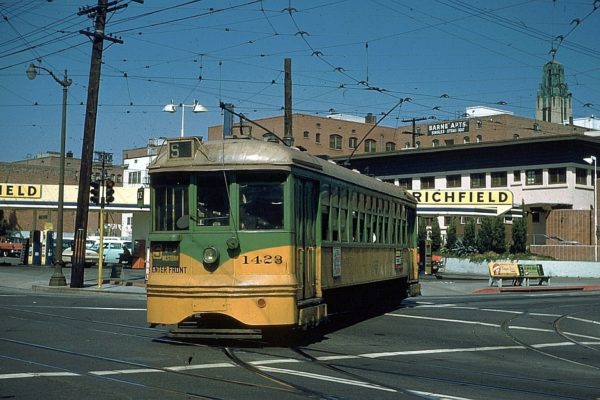During 1919-1920, the engineers of the Los Angeles Railway designed a new type of car for the Eagle Rock-Hawthorne ‘E Line’. These cars, designated Type H, were to be the first LARy cars of all steel construction and the first to be equipped with control equipment and couplers for multiple-unit operation. The Type H cars were intended to supplement and eventually replace the wooden bodied, single unit operation Type B ‘Huntington Standard’ cars. 25 cars were ordered from St. Louis Car Company in 1920 and were numbered 1201-1225. The cars arrived in 1921, with their electrical components installed by LARy at their South Park Shops. Car 1201 was the first car to make a trial trip on the E Line to Hawthorne in November, 1921. The new cars were found to be under-powered as they were equipped with two motors. The Type H cars were used instead on the Grand Ave-Moneta Line, with first multiple-unit operations taking place on November 23, 1921.
Proving most successful, another 225 cars were ordered:
- 1226-1275, Type H-1, order placed June 2, 1922, arriving November 1922.
- 1276-1325, Type H-2, order placed January 3, 1923.
- 1326-1350, Type H-2, order placed May 31, 1923.
- 1351-1450, Type H-2, order placed December, 12, 1923, delivered 1924.
1450 was unique in being a ‘test car’. While the Type H cars had Westinghouse mechanical components, 1450 had a mix of Westinghouse and General Electric components.
In 1928, Los Angeles Railway raised the car fare from 5 cents to 7 cents. In response to negative feedback from riders, cars 1441-1450 were modernized in December of 1929 and re-designated as Type H-3. The controls of H-3 cars were mechanically redesigned to be capable of one man (operator only) or two man (operator and conductor) operation. Automatic double doors were installed on each end of the cars complete with folding steps. For the comfort of the passengers, the two open sections had windows installed with added ventilation ports between the sections. The car interior was upgraded, including the addition of leather upholstered seats. Most shocking to the public, the cars were painted a cream and green paint scheme with gold lettering. Type H-3 1441 was the debuted to the public on August 13, 1930 and proved extremely popular. Cars 1416-1440 were subsequently converted to Type H-3 between November 1930 and January 1931 for service on the E Line. As cars were sent to South Park Shops for routine maintenance, the H-3’s were painted back into the standard LARy yellow and brown livery, with all of the H-3’s repainted by 1934.
In 1934, cars 1201-1220 were modernized and converted to be used by either a single motorman or by a motorman and conductor. This new H-4 subclass also had multiple unit controls and couplers removed and dead man safety control was installed. Modernized features included automatic folding doors and steps, hunter roller sign and improved lighting. Cars 1221-1415 were also upgraded to Type H-4 during 1935 and 1936. Use of multiple unit control was discontinued in January of 1939. A last run of the H-3 cars in multiple unit operation was conducted with cars 1421 and 1432 on January, 13, 1939 by the Railroad Boosters.
The Los Angeles Railway was sold in January, 1945 to Los Angeles Transit Lines, a subsidiary of National City Lines. LATL began a modernization campaign of the Type H-4 cars in mid-1945. Eclipse fenders were removed in favor of lifeguard fenders. Skirting under the car body gave a semi streamlined appearance. Most noticeably, the cars were repainted into the yellow, green, and cream National City Lines “Fruit Salad” livery. The Type H-3 cars followed in 1947, with full modernization and conversion to one man operation.
1955 saw a major abandonment of rail service with the F, 5, 7, 8, and 9 Lines being replaced with bus service causing a mass retirement of 195 Type H-4 cars. Retired cars were sold to National Metals for scrap and disposition. 61 cars were sold and saw many more years of service in Seoul, South Korea. LATL donated 1201 to the city of Inglewood in 1955, where it was placed on display in Centinela Park. 1201 quickly became victim to vandals and became an eye sore. The Southern California Electric Railroaders Association acquired the car from the city of Inglewood and relocated it to Travel Town in Griffith Park. In 1959, 1201 and many other streetcars were moved to the new Orange Empire Traction Museum (now Southern California Railway Museum) in Perris, CA. LATL also donated 1318 to the Oregon Electric Railway Historical Society in Glenwood, Oregeon.
The Type H-3 and 19 remaining Type H-4 cars continued to serve the S and W Lines with supplemental night service on the R Line. With the abandonment of the W Line in 1956, the H-3 cars and eight H-4’s served the S Line. Los Angeles Transit Lines was absorbed by the Los Angeles Metropolitan Transit Authority in March, 1958. LAMTA installed turning loops at the end of the S Line to accommodate the streamlined Type P, single ended PCC cars. The last of the Type H cars were retired in the summer of 1958 and placed into storage. 1450 had the distinction of being the last Type Car operated in Los Angeles in 1958 on and Excursion sponsored by SCERA. Cars 1423, 1444, and 1450 were sold to the Orange Empire Trolley Museum (now Southern California Railway Museum) and moved to the museum in Perris, California. 1435 was also sold to a private party. The remaining cars were sold for scrap to National Metals.
Today, 1423 is on display at the Southern California Railway Museum with the Los Angeles Railway Collection in Carbarn 1. While currently inoperable, is in need of a full mechanical and cosmetic restoration. Donations to the SCRM Yellow Car Fund keep the Los Angeles Railway cars in service and facilitate future restoration of other cars, such as 1423.

